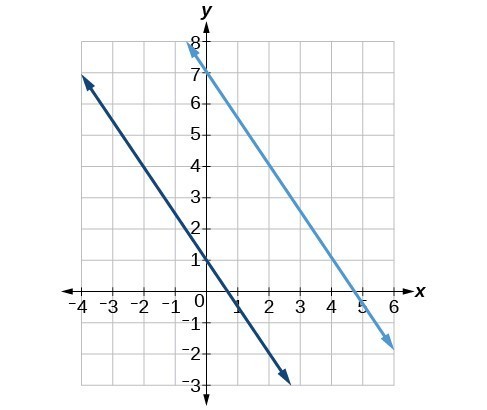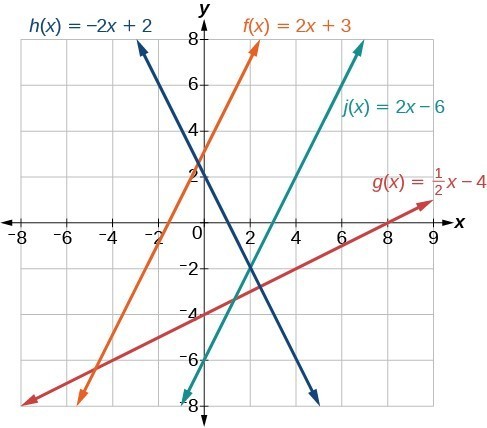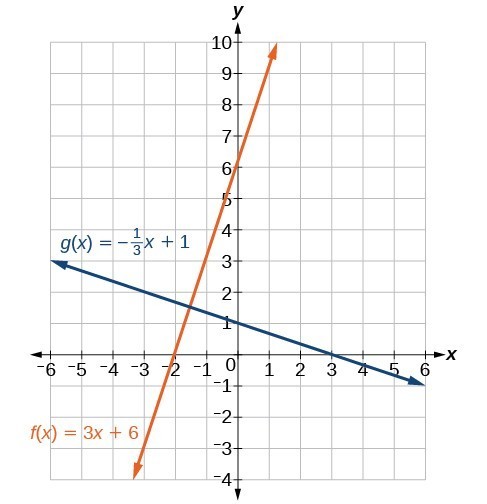Parallel and Perpendicular Lines
Learning Outcomes
- Determine whether lines are parallel or perpendicular given their equations
- Find equations of lines that are parallel or perpendicular to a given line
 Parallel lines.
Parallel lines. We can determine from their equations whether two lines are parallel by comparing their slopes. If the slopes are the same and the y-intercepts are different, the lines are parallel. If the slopes are different, the lines are not parallel.
Unlike parallel lines, perpendicular lines do intersect. Their intersection forms a right or 90-degree angle. The two lines below are perpendicular.
We can determine from their equations whether two lines are parallel by comparing their slopes. If the slopes are the same and the y-intercepts are different, the lines are parallel. If the slopes are different, the lines are not parallel.
Unlike parallel lines, perpendicular lines do intersect. Their intersection forms a right or 90-degree angle. The two lines below are perpendicular.
 Perpendicular lines.
Perpendicular lines.To find the reciprocal of a number, divide 1 by the number. So the reciprocal of 8 is , and the reciprocal of is 8. To find the negative reciprocal, first find the reciprocal and then change the sign. As with parallel lines, we can determine whether two lines are perpendicular by comparing their slopes. The slope of each line below is the negative reciprocal of the other so the lines are perpendicular.
The product of the slopes is –1.
A General Note: Parallel and Perpendicular Lines
Two lines are parallel lines if they do not intersect. The slopes of the lines are the same..
If and only if and , we say the lines coincide. Coincident lines are the same line. Two lines are perpendicular lines if they intersect at right angles..
tip for success
Be careful when discussing horizontal and vertical lines as being perpendicular by having slopes whose product is . We can use the qualifying statement above, though, to cover the case of horizontal and vertical lines. Ex. Certainly the lines and are perpendicular. The slope of the horizontal line is . The slope of the vertical line is , which is undefined. But what about the requirement for negative, reciprocal slopes? In this case, the reciprocal characteristic holds. Since negativity is defined in proximity to zero, we may qualify this special case as perpendicular. But, when discussing function graphs that are perpendicular to each other, it makes no sense to discuss the possibility of horizontal and vertical functions. A vertical line fails to be a function by the vertical line test.Example: Identifying Parallel and Perpendicular Lines
Given the functions below, identify the functions whose graphs are a pair of parallel lines and a pair of perpendicular lines.
Answer: Parallel lines have the same slope. Because the functions and each have a slope of 2, they represent parallel lines. Perpendicular lines have negative reciprocal slopes. Because −2 and are negative reciprocals, the equations, and represent perpendicular lines.
Analysis of the Solution
A graph of the lines is shown below. The graph shows that the lines and are parallel, and the lines and are perpendicular.
The graph shows that the lines and are parallel, and the lines and are perpendicular.Writing Equations of Parallel Lines
If we know the equation of a line, we can use what we know about slope to write the equation of a line that is either parallel or perpendicular to the given line. Suppose we are given the following function:We know that the slope of the line is 3. We also know that the y-intercept is (0, 1). Any other line with a slope of 3 will be parallel to f(x). The lines formed by all of the following functions will be parallel to f(x).
Suppose then we want to write the equation of a line that is parallel to f and passes through the point (1, 7). We already know that the slope is 3. We just need to determine which value for b will give the correct line. We can begin by using point-slope form of an equation for a line. We can then rewrite it in slope-intercept form.
So is parallel to and passes through the point (1, 7).
How To: Given the equation of a linear function, write the equation of a line WHICH passes through a given point and is parallel to the given line.
- Find the slope of the function.
- Substitute the slope and given point into point-slope or slope-intercept form.
- Simplify.
Example: Finding a Line Parallel to a Given Line
Find a line parallel to the graph of that passes through the point (3, 0).Answer: The slope of the given line is 3. If we choose slope-intercept form, we can substitute , , and into slope-intercept form to find the y-intercept.
The line parallel to f(x) that passes through (3, 0) is .
Analysis of the Solution
We can confirm that the two lines are parallel by graphing them. The figure below shows that the two lines will never intersect.
Writing Equations of Perpendicular Lines
We can use a very similar process to write the equation of a line perpendicular to a given line. Instead of using the same slope, however, we use the negative reciprocal of the given slope. Suppose we are given the following function:The slope of the line is 2, and its negative reciprocal is . Any function with a slope of will be perpendicular to f(x). The lines formed by all of the following functions will be perpendicular to f(x).
As before, we can narrow down our choices for a particular perpendicular line if we know that it passes through a given point. Suppose that we want to write the equation of a line that is perpendicular to f(x) and passes through the point (4, 0). We already know that the slope is . Now we can use the point to find the y-intercept by substituting the given values into the slope-intercept form of a line and solving for b.
The equation for the function with a slope of and a y-intercept of 2 is
.
So is perpendicular to and passes through the point (4, 0). Be aware that perpendicular lines may not look obviously perpendicular on a graphing calculator unless we use the square zoom feature.Q & A
A horizontal line has a slope of zero and a vertical line has an undefined slope. These two lines are perpendicular, but the product of their slopes is not –1. Doesn’t this fact contradict the definition of perpendicular lines? No. For two perpendicular linear functions, the product of their slopes is –1. However, a vertical line is not a function so the definition is not contradicted.How To: Given the equation of a linear function, write the equation of a line WHICH passes through a given point and is Perpendicular to the given line.
- Find the slope of the given function.
- Determine the negative reciprocal of the slope.
- Substitute the new slope and the values for x and y from given point into .
- Solve for b.
- Write the equation of the line.
Example: Finding the Equation of a Perpendicular Line
Find the equation of a line perpendicular to that passes through the point (3, 0).Answer: The original line has slope , so the slope of the perpendicular line will be its negative reciprocal, or . Using this slope and the given point, we can find the equation for the line.
The line perpendicular to f(x) that passes through (3, 0) is .
Analysis of the Solution
A graph of the two lines is shown below.
Try It
Using an online graphing calculator, create a line that passes through the points and , call this . Now create a line that is parallel to that first line, let's call this .- For what y-intercept will the graph of pass through the point ?
- Add a new function, that uses the slope that will create a line that is perpendicular to the function .
- For what y-intercept will the new function pass through the point , and still be perpendicular to
Answer:
- When the y-intercept is the function will be and the function will pass through the point .
- for example. Any value for the y-intercept will work.
- The y-intercept will give a line perpendicular to that passes through the point .
How To: Given two points on a line and a third point, write the equation of the perpendicular line that passes through the point.
- Determine the slope of the line passing through the points.
- Find the negative reciprocal of the slope.
- Use slope-intercept form or point-slope form to write the equation by substituting the known values.
- Simplify.
Example: Finding the Equation of a Line going through a point and Perpendicular to a Given Line
A line passes through the points (–2, 6) and (4, 5). Find the equation of a line that is perpendicular and passes through the point (4, 5).Answer: From the two points of the given line, we can calculate the slope of that line.
Find the negative reciprocal of the slope.
We can then solve for the y-intercept of the line passing through the point (4, 5).
The equation of the line that passes through the point (4, 5) and is perpendicular to the line passing through the two given points is .
Try It
A line passes through the points, (–2, –15) and (2, –3). Find the equation of a perpendicular line that passes through the point, (6, 4).Answer:
